The history of the cash register: from past to present
By Alexander -
Apr 22, 2025
- 7 minutes read
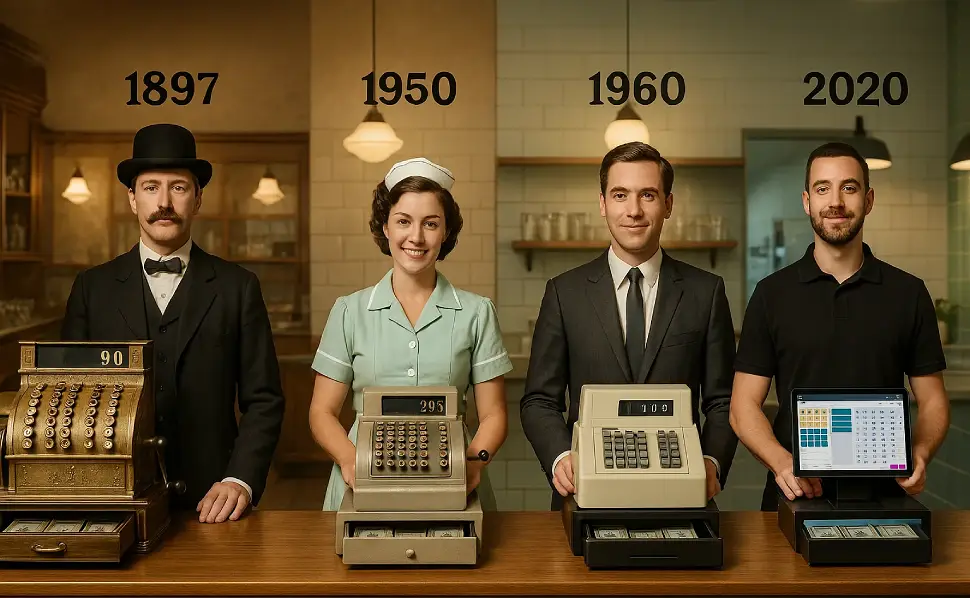
The Birth of the Cash Register: A Chronological Journey
Cash registers and drawers have become a common sight in stores, restaurants, hotels, bars, garages, and beyond. Their history is a captivating tale dating back to the 19th century. From simple mechanical devices to intricate digital systems, the cash register's evolution reflects significant technological and economic developments.
This article takes you on a journey through time, detailing the origin and development of the cash register chronologically.
What Does the Word "Cash Register" Mean?
The term "cash register" originates from the French word caisse, meaning "money chest," which in turn derives from the Latin capsa, meaning "box" or "chest." The original meaning referred to a physical container for money, laying the foundation for later technological applications.
The Need for Control in the 19th Century
During the 19th century, retail rapidly expanded, particularly in the United States and Europe, creating a challenge for business owners: employee theft or pilfering. A system was needed to reliably record transactions and monitor income. The necessity was evident, but how could it be resolved?
This article takes you on a journey through time, detailing the origin and development of the cash register chronologically.
What Does the Word "Cash Register" Mean?
The term "cash register" originates from the French word caisse, meaning "money chest," which in turn derives from the Latin capsa, meaning "box" or "chest." The original meaning referred to a physical container for money, laying the foundation for later technological applications.
The Need for Control in the 19th Century
During the 19th century, retail rapidly expanded, particularly in the United States and Europe, creating a challenge for business owners: employee theft or pilfering. A system was needed to reliably record transactions and monitor income. The necessity was evident, but how could it be resolved?
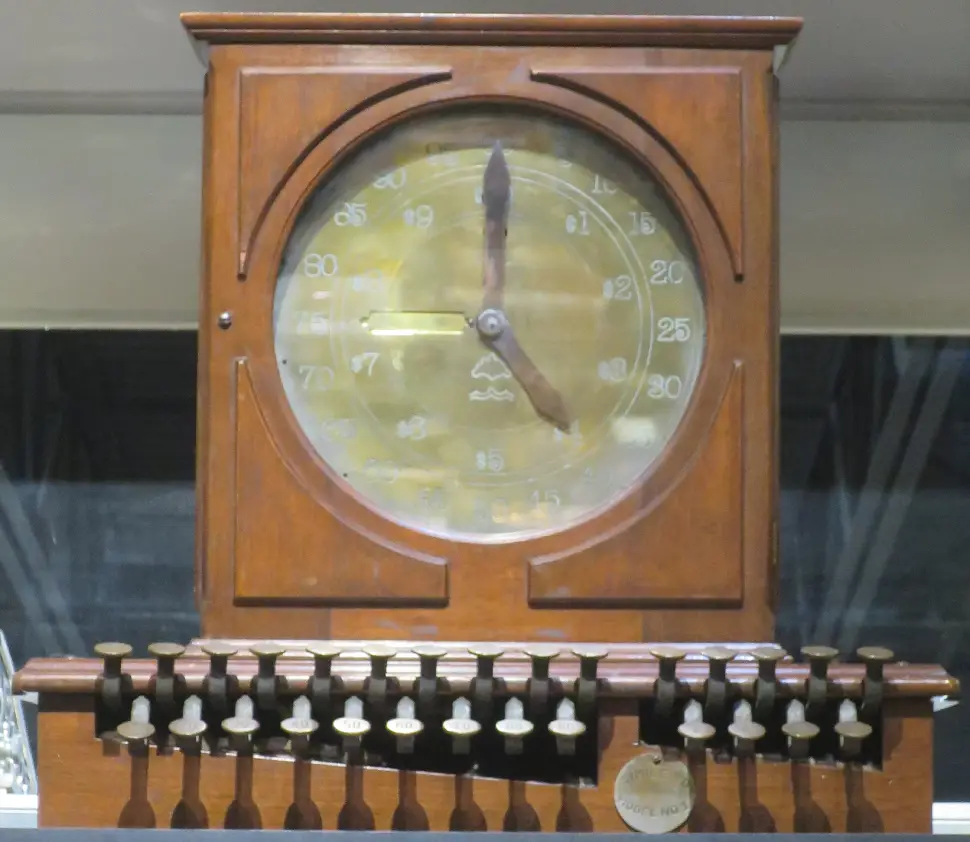
This is a reproduction of James Ritty's cash register. Photo: Wikipedia
1879 - The First Cash Register: James Ritty
The first cash registers operated using a manual crank. Turning the crank opened the cash drawer and recorded the transaction, highlighting the mechanical nature of these early devices.
James Ritty came up with the idea for his invention while traveling in Europe after seeing a device that counted the rotations of a ship’s propeller. Inspired by this, he created a similar mechanism to track sales in his saloon.
He and his brother John founded "Ritty's Manufacturing Company," which produced the first mechanical cash registers. In 1879, they designed a machine called the "Incorruptible Cashier," which recorded each sale and reduced the risk of theft. Ritty patented his design in 1883. He filed his patent application on September 21, 1883, and it was granted on May 26, 1885.
James Ritty came up with the idea for his invention while traveling in Europe after seeing a device that counted the rotations of a ship’s propeller. Inspired by this, he created a similar mechanism to track sales in his saloon.
He and his brother John founded "Ritty's Manufacturing Company," which produced the first mechanical cash registers. In 1879, they designed a machine called the "Incorruptible Cashier," which recorded each sale and reduced the risk of theft. Ritty patented his design in 1883. He filed his patent application on September 21, 1883, and it was granted on May 26, 1885.

Photo illustration of James Ritty: © HRC DIGITAL B.V. - Inset photo of James Ritty: Wikipedia
1884 - National Cash Register (NCR)
Ritty's patent was acquired by John H. Patterson in 1884. Patterson founded what would become the National Cash Register Company (NCR). Under NCR's leadership, the production and distribution of cash registers were refined to include features such as:
These innovations made cash registers popular among retailers worldwide. The bell and its distinctive "clinking" sound acted as audible confirmation of a sale and served a psychological purpose by reminding staff that their actions were audible and thus overseen.
From Mechanical to Electromechanical: Early 20th Century
During this period, cash registers became more decorative. Many models were crafted from copper or bronze and adorned with ornate designs and engravings. They served as functional devices and eye-catching status symbols in retail settings.
Refining the Technology
In the early 20th century, cash registers were enhanced with electrical and mechanical components, such as lockable cash drawers, electromagnets, and motors. NCR maintained its market leadership, but competitors like Sweda and the Victor Adding Machine Company emerged.
1920–1930: Cash registers with integrated calculators
During this period, manufacturers began integrating calculating functions to facilitate quicker calculation of discounts, taxes, and totals.
1960–1980: The Electronic Revolution
First Electronic Cash Registers (ECR):
The first electronic cash registers (ECRs) emerged in the 1960s, utilizing transistors and basic memory to store transactions. Key features included:
- A paper receipt
- An automatically opening cash drawer
- A bell that rang with each transaction
These innovations made cash registers popular among retailers worldwide. The bell and its distinctive "clinking" sound acted as audible confirmation of a sale and served a psychological purpose by reminding staff that their actions were audible and thus overseen.
From Mechanical to Electromechanical: Early 20th Century
During this period, cash registers became more decorative. Many models were crafted from copper or bronze and adorned with ornate designs and engravings. They served as functional devices and eye-catching status symbols in retail settings.
Refining the Technology
In the early 20th century, cash registers were enhanced with electrical and mechanical components, such as lockable cash drawers, electromagnets, and motors. NCR maintained its market leadership, but competitors like Sweda and the Victor Adding Machine Company emerged.
1920–1930: Cash registers with integrated calculators
During this period, manufacturers began integrating calculating functions to facilitate quicker calculation of discounts, taxes, and totals.
1960–1980: The Electronic Revolution
First Electronic Cash Registers (ECR):
The first electronic cash registers (ECRs) emerged in the 1960s, utilizing transistors and basic memory to store transactions. Key features included:
- Digital displays
- Programmable keys
- Internal data storage
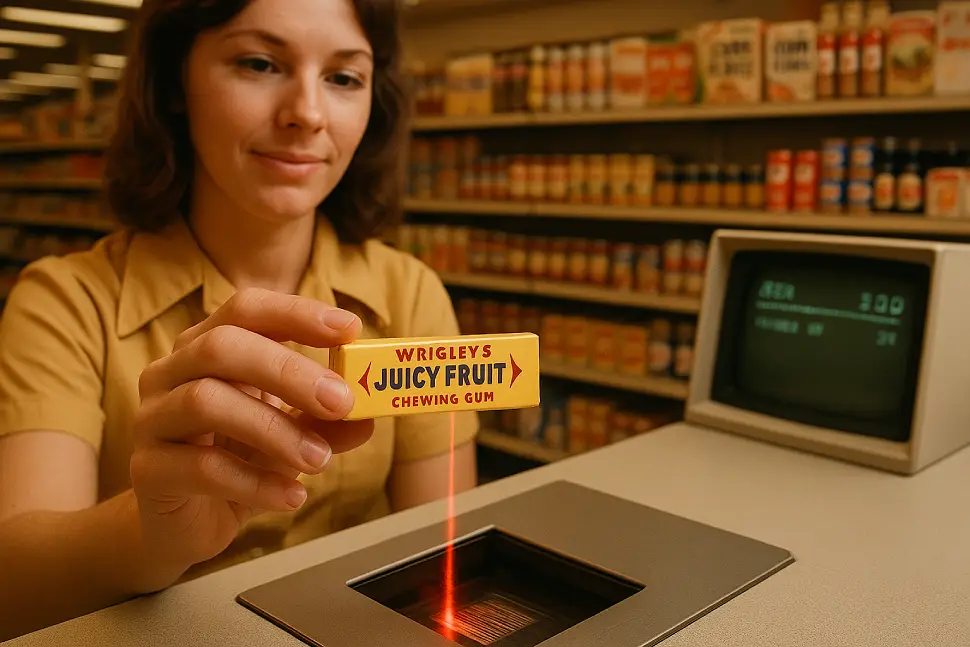
Photo illustration of the first barcode scan: © HRC DIGITAL B.V.
1974: Barcodes and Scanners
The first UPC barcode was scanned in a supermarket in Ohio in 1974: a pack of Wrigley's gum. This event revolutionized cash register technology.
The combination of ECRs with barcodes marked the birth of true point-of-sale (POS) systems.
1990–2000: Software and Networks The Rise of the PC Cash Register
From the 1990s onward, cash register systems transitioned to standard PC architecture. The focus shifted from hardware to software, with applications such as the Microsoft Retail Management System (RMS), Exact for Retail, and HRC POS dominating the market.
These systems offered a new generation of functionality, including:
Additionally, connections to external systems became more common:
The cash register evolved from a standalone system into a central hub in the retail landscape and was increasingly positioned visibly as a symbol of honesty and transparency for customers.
Dutch context:
In the Netherlands, electronic cash registers were quickly adopted starting in the 1970s, driven by the growth of supermarkets. Receipts assumed a multifaceted role as proof of purchase for warranties and returns and were increasingly recognized as legal documents for complaints, returns, and warranty claims, thereby enhancing consumer protection. Cash registers were often displayed prominently to demonstrate transparency and honesty with customers.
The first UPC barcode was scanned in a supermarket in Ohio in 1974: a pack of Wrigley's gum. This event revolutionized cash register technology.
- Speeding up checkout
- improving inventory management through POS systems
- reducing errors from manual input
The combination of ECRs with barcodes marked the birth of true point-of-sale (POS) systems.
1990–2000: Software and Networks The Rise of the PC Cash Register
From the 1990s onward, cash register systems transitioned to standard PC architecture. The focus shifted from hardware to software, with applications such as the Microsoft Retail Management System (RMS), Exact for Retail, and HRC POS dominating the market.
These systems offered a new generation of functionality, including:
- Real-time inventory management integration
- Customer management via integrated CRM features
- Comprehensive reporting and analytics
Additionally, connections to external systems became more common:
- Accounting software
- Web shops
- Payment terminals
- Loyalty programs
The cash register evolved from a standalone system into a central hub in the retail landscape and was increasingly positioned visibly as a symbol of honesty and transparency for customers.
Dutch context:
In the Netherlands, electronic cash registers were quickly adopted starting in the 1970s, driven by the growth of supermarkets. Receipts assumed a multifaceted role as proof of purchase for warranties and returns and were increasingly recognized as legal documents for complaints, returns, and warranty claims, thereby enhancing consumer protection. Cash registers were often displayed prominently to demonstrate transparency and honesty with customers.
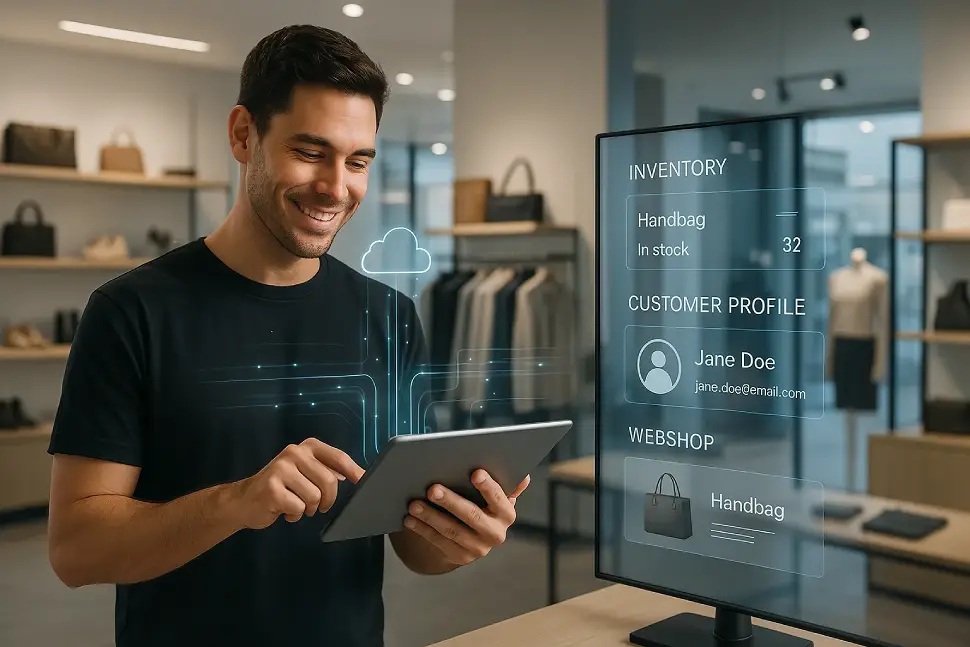
Photo illustration of a cloud-based point-of-sale system (POS): © HRC DIGITAL B.V.
2010: Mobile and cloud-based cash registers
Modern cash register systems are becoming increasingly important for omnichannel sales strategies. These systems connect physical stores to web shops and manage inventory, customer data, and sales information within a single system. When an item is processed at the register, it is automatically deducted from stock. POS systems play a crucial role in the hospitality industry by freeing up time for entrepreneurs.
Mobile POS (mPOS)
The rise of smartphones and tablets has given birth to mobile point-of-sale (mPOS) systems.
These systems offer low setup costs, high transaction fees, and user-friendly interfaces. They are popular with small business owners, marketplaces, and businesses in the hospitality sector.
Cloud-based POS systems
During this period, user-friendliness became a key consideration. In sectors like hospitality and retail, which often employ temporary staff, it's essential that new employees quickly learn to operate cash register systems.
POS Systems with AI, Automation, and Future Outlook: 2020 and Beyond:
AI-driven insights
Modern POS systems collect vast amounts of data. By employing artificial intelligence, entrepreneurs can:
Moreover, cash register systems are increasingly being used as strategic business tools. Through dashboards and predictive algorithms, entrepreneurs can make informed decisions about inventory, staffing, and pricing based on real-time data.
The Cash Register of the Future
According to the Foundation for Reliable Checkout Systems (FRCS), the future of cash registers involves a modular, cloud-native platform where hardware and software work together seamlessly. Key developments include:
Seamless integration with back office, ERP, and accounting systems
This evolution means that cash registers and drawers are becoming less and less standalone devices and more and more integral components of a broader IT infrastructure!
Modern cash register systems are becoming increasingly important for omnichannel sales strategies. These systems connect physical stores to web shops and manage inventory, customer data, and sales information within a single system. When an item is processed at the register, it is automatically deducted from stock. POS systems play a crucial role in the hospitality industry by freeing up time for entrepreneurs.
Mobile POS (mPOS)
The rise of smartphones and tablets has given birth to mobile point-of-sale (mPOS) systems.
- iZettle (now part of PayPal).
- SumUp
- Square.
These systems offer low setup costs, high transaction fees, and user-friendly interfaces. They are popular with small business owners, marketplaces, and businesses in the hospitality sector.
Cloud-based POS systems
- Cloud-based systems like Shopify POS, Lightspeed, Vend, HRC One POS, and Booq have enabled real-time storage of register data in the cloud.
- Real-time storage of register data in the cloud
- Remote store management
- Automatic backups
During this period, user-friendliness became a key consideration. In sectors like hospitality and retail, which often employ temporary staff, it's essential that new employees quickly learn to operate cash register systems.
POS Systems with AI, Automation, and Future Outlook: 2020 and Beyond:
- Self-Service Registers
- Supermarkets and large chains are embracing self-service, allowing customers to scan and pay for items on their own. Technologies like visual recognition (e.g., Amazon Go) and RFID make completely cashless stores possible.
AI-driven insights
Modern POS systems collect vast amounts of data. By employing artificial intelligence, entrepreneurs can:
- Predict sales trends
- Automatically reorder stock
- Optimize pricing strategies
- Analyze customer behavior and offer personalized promotions
- Adjust marketing campaigns based on register data
Moreover, cash register systems are increasingly being used as strategic business tools. Through dashboards and predictive algorithms, entrepreneurs can make informed decisions about inventory, staffing, and pricing based on real-time data.
The Cash Register of the Future
According to the Foundation for Reliable Checkout Systems (FRCS), the future of cash registers involves a modular, cloud-native platform where hardware and software work together seamlessly. Key developments include:
Seamless integration with back office, ERP, and accounting systems
- Real-time data synchronization between branches and webshops
- Smart recommendation algorithms for sales staff
- Fully digital transaction streams, including e-receipts and automated invoice matching
- Increased focus on security and compliance (such as fiscalization)
This evolution means that cash registers and drawers are becoming less and less standalone devices and more and more integral components of a broader IT infrastructure!
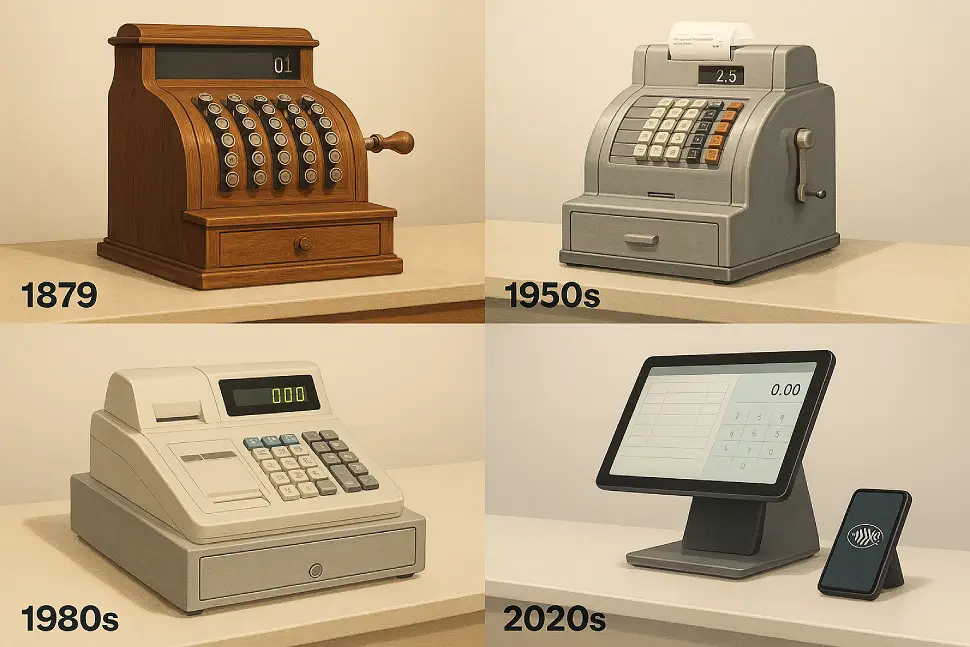
Photo illustration of POS through the years. © HRC DIGITAL B.V.
Summary
The cash register has undergone an impressive evolution, from a mechanical box in a saloon to sophisticated, AI-driven cloud solutions. Each phase of its development reflects broader societal, technological, and economic trends. Initially conceived as a theft deterrent, it has evolved into the central nervous system of modern retail, hospitality, and gastronomy. The future promises further automation and deeper integration with other systems. It may even see the disappearance of the physical cash register, replaced by invisible embedded payment solutions.